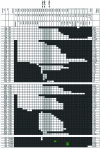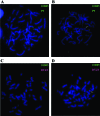Enhancer deletions of the SHOX gene as a frequent cause of short stature: the essential role of a 250 kb downstream regulatory domain
- PMID: 19578035
- PMCID: PMC2778764
- DOI: 10.1136/jmg.2009.067785
Enhancer deletions of the SHOX gene as a frequent cause of short stature: the essential role of a 250 kb downstream regulatory domain
Abstract
Background: Mutations and deletions of the homeobox transcription factor gene SHOX are known to cause short stature. The authors have analysed SHOX enhancer regions in a large cohort of short stature patients to study the importance of regulatory regions in developmentally relevant genes like SHOX.
Methods: The authors tested for the presence of copy number variations in the pseudoautosomal region of the sex chromosomes in 735 individuals with idiopathic short stature and compared the results to 58 cases with Leri-Weill syndrome and 100 normal height controls, using fluorescence in situ hybridisation (FISH), single nucleotide polymorphism (SNP), microsatellites, and multiplex ligand dependent probe amplification (MLPA) analysis.
Results: A total of 31/735 (4.2%) microdeletions were identified in the pseudoautosomal region in patients with idiopathic short stature; eight of these microdeletions (8/31; 26%) involved only enhancer sequences residing a considerable distance away from the gene. In 58 Leri-Weill syndrome patients, a total of 29 microdeletions were identified; almost half of these (13/29; 45%) involve enhancer sequences and leave the SHOX gene intact. These deletions were absent in 100 control persons.
Conclusion: The authors conclude that enhancer deletions in the SHOX gene region are a relatively frequent cause of growth failure in patients with idiopathic short stature and Leri-Weill syndrome. The data highlights the growing recognition that regulatory sequences are of crucial importance in the genome when diagnosing and understanding the aetiology of disease.
Conflict of interest statement
GW, DS and JD are (or were) employees of the Bioscientia Institute of Medical Genetics, WB is an employee of Eli Lilly and company. GR is a patent owner and has been reimbursed by Eli Lilly for attending and speaking at several conferences. JC, ZZ, RR, and BW have no competing interests.
Figures




References
-
- Gudbjartsson DF, Walters GB, Thorleifsson G, Stefansson H, Halldorsson BV, Zusmanovich P, Sulem P, Thorlacius S, Gylfason A, Steinberg S, Helgadottir A, Ingason A, Steinthorsdottir V, Olafsdottir EJ, Olafsdottir GH, Jonsson T, Borch-Johnsen K, Hansen T, Andersen G, Jorgensen T, Pedersen O, Aben KK, Witjes JA, Swinkels DW, den Heijer M, Franke B, Verbeek AL, Becker DM, Yanek LR, Becker LC, Tryggvadottir L, Rafnar T, Gulcher J, Kiemeney LA, Kong A, Thorsteinsdottir U, Stefansson K. Many sequence variants affecting diversity of adult human height. Nat Genet 2008;40:609–15 - PubMed
-
- Lettre G, Jackson AU, Gieger C, Schumacher FR, Berndt SI, Sanna S, Eyheramendy S, Voight BF, Butler JL, Guiducci C, Illig T, Hackett R, Heid IM, Jacobs KB, Lyssenko V, Uda M, Diabetes Genetics Initiative, FUSION, KORA, Prostate, Lung Colorectal and Ovarian Cancer Screening Trial, Nurses’ Health Study, SardiNIA, Boehnke M, Chanock SJ, Groop LC, Hu FB, Isomaa B, Kraft P, Peltonen L, Salomaa V, Schlessinger D, Hunter DJ, Hayes RB, Abecasis GR, Wichmann HE, Mohlke KL, Hirschhorn JN. Identification of ten loci associated with height highlights new biological pathways in human growth. Nat Genet 2008;40:584–91 - PMC - PubMed
-
- Weedon MN, Lango H, Lindgren CM, Wallace C, Evans DM, Mangino M, Freathy RM, Perry JR, Stevens S, Hall AS, Samani NJ, Shields B, Prokopenko I, Farrall M, Dominiczak A, Diabetes Genetics Initiative, Wellcome Trust Case Control Consortium, Johnson T, Bergmann S, Beckmann JS, Vollenweider P, Waterworth DM, Mooser V, Palmer CN, Morris AD, Ouwehand WH, Cambridge GEM Consortium, Zhao JH, Li S, Loos RJ, Barroso I, Deloukas P, Sandhu MS, Wheeler E, Soranzo N, Inouye M, Wareham NJ, Caulfield M, Munroe PB, Hattersley AT, McCarthy MI, Frayling TM. Genome-wide association analysis identifies 20 loci that influence adult height. Nat Genet 2008;40:575–83 - PMC - PubMed
-
- Cohen P, Rogol AD, Deal CL, Saenger P, Reiter EO, Ross JL, Chernausek SD, Savage MO, Wit JM, 2007 ISS Consensus Workshop participants Consensus statement on the diagnosis and treatment of children with idiopathic short stature. J Clin Endocrinol Metab 2008;93:4210–7 - PubMed
-
- Ellison JW, Wardak Z, Young MF, Gehron Robey P, Laig-Webster M, Chiong W. PHOG, a candidate gene for involvement in the short stature of Turner syndrome. Hum Mol Genet 1997;6:1341–7 - PubMed
Publication types
MeSH terms
Substances
LinkOut - more resources
Full Text Sources
Medical
Molecular Biology Databases
Research Materials
